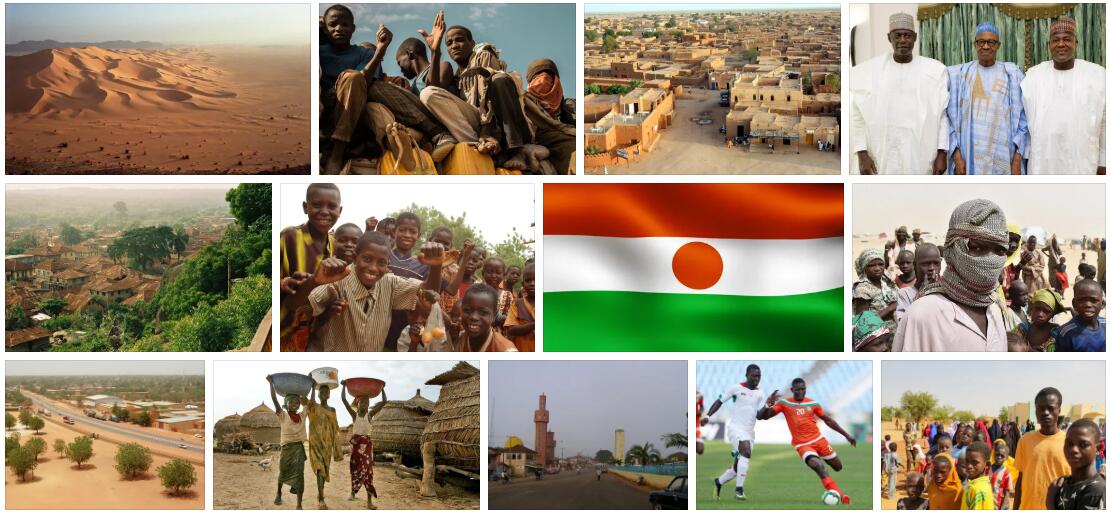According to ABBREVIATIONFINDER, Niger is a landlocked country in West Africa. It is the sixth largest country on the continent. It stretches from the central reaches of the Niger River in the southwest across the Sahel to the Sahara in the northeast.
Most of the country is covered by vast plains with a desert character. The Aïr mountains rise up from them in the Sahara with heights of up to 2310 m. In Niger there is a semi-arid to fully arid climate. In the southern part of the country there is only a rainy season between May and October. The whole country is hot and mostly dry. Dry savannas, thorn bush savannahs and semi-deserts cover the land.
Niger is a multi-ethnic state. The Hausa are the largest ethnic group with around 54% of the population. The Berber people of the Tuareg still roam the Sahara and the Sahel region today. Niger is very sparsely populated. It is one of the poorest countries in the world. The economy is based on agriculture. It is limited to the Niger region in the south. Niger has uranium deposits that are being mined. The industry is poorly developed.
Niger borders Algeria and Libya to the north, Chad to the east, Nigeria to the south, Benim and Burkina Faso to the southwest, and Mali to the west. In terms of area, Niger is more than three times the size of Germany. It is the sixth largest country on the continent of Africa.
Niger lies in the transition zone between Berber-Arab and Black African Africa (Fig. 1). The capital is Niamey.
Important data about the country
| Surface: | 1,267,000 km² |
| Residents: | 12.4 million |
| Population density: | 10 residents / km² |
| Growth of population: | 3.6% / year |
| Life expectancy: | 46 years |
| State capital: | Niamey |
| Form of government: | republic |
| Languages: | Hausa, Songhai-Jerma, Fulbe, Tamaschagh, Kanouri, French |
| Religions: | Muslim 80%, followers of natural religions 10–15% |
| Climate: | semi-arid to fully arid climate |
| Land use: | Arable land 3%, pasture land 7.3% (88% of the land area is desert) |
| Economic sectors: (share of employees) |
Agriculture 40%, industry 17%, services 43% |
| Export goods: | Uranium, animals |
| Gross domestic product: | US $ 2,731 million (2003) |
| Gross National Product: | US $ 200 / residents (2003) |
Surface shape
Most of the landlocked country stretches from the central reaches of the Niger River in the southwest over the Sahel to the Sahara.
In the center of the country, the Aïr mountains protrude from the Sahara with heights of up to 2310 m. In the extreme north there are plateaus at an altitude of 500 to 1000 m. Most of the country is taken up by vast desert landscapes. These include the Ténéré sand desert and the Kaouar desert region in the east. These Sahara regions extend to the border with Chad. The far north-east of Niger is covered by the foothills of the Chadian Tibetan Mountains. In the southeast, Niger has a share of Lake Chad.
Waters
The Niger determines the southwest of the country. With a length of 4160 km, it is the third largest river in Africa. It rises in southern Guinea and flows through Niger over a length of 650 km. Only this region can be used for agriculture.
Climate and vegetation
The climate across the country is predominantly dry and hot. It is semi-arid in the south and fully arid in the north . Only in the southern part of Niger is there a rainy season between May and October. During this period, almost all of the annual precipitation falls. It is between 400 and 700 mm (Fig. 3). While precipitation fell in the south-west in the 1990’s, there was often no rain in the northern Sahel zone in recent decades.
The vegetation in the south consists of dry savannah with grasses, thorn bushes and dry forest areas. Overgrazing and persistent drought, the vegetation of the savannah has been severely decimated in recent decades. To the north the dry savannah goes inThorn bush savannah and semi-desert almost without vegetation.
Economy
Niger is one of the poorest countries in the world. The economy is based on agriculture. However, the cultivation areas are limited to the Niger region in the south and the oases. Millet, cassava, potatoes, rice and legumes are mainly grown as staple foods. Peanuts and vegetables are planted for export.
The uranium deposits in Niger are mined for the 1971st They were a safe source of income until the mid-1980’s. However, with the drop in prices on the world market, revenues fell. In addition to uranium ore, tin ore, coal, iron ore and phosphate are mined.
The industry is poorly developed. It only employs 6% of the workforce. The main branches are textile, food and wood industries. Important trading partners for the export products uranium, peanuts and cattle are France and Nigeria. Niger has no railroad. The roads are in poor condition. The main route is the Niger. However, it is only navigable between the capital Niamey and Sala-Malanwille from September to March. To this day, in some regions of Niger, caravans are important for the trade in salt and dates.
History
From the 11th to the 16th centuries: Empire of the Tuareg
In the 19th century: exploration and colonization
Since 1922: Niger becomes a French colony.
Joins the Federation of French West Africa
3.8.1960: Independence from France and since then a republic
Since 1990: Ongoing fighting between the government and the Tuareg
1994: Armistice
April 1995: Peace treaty





